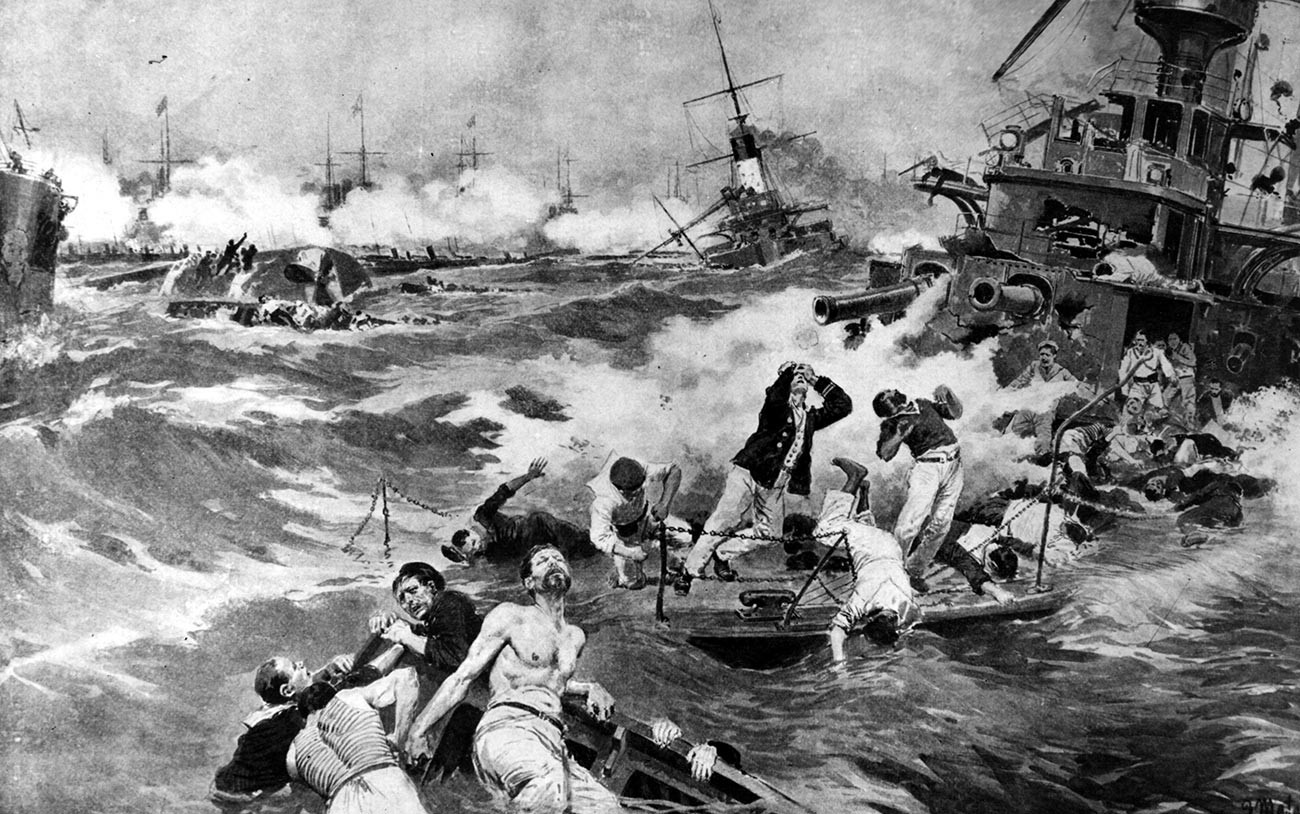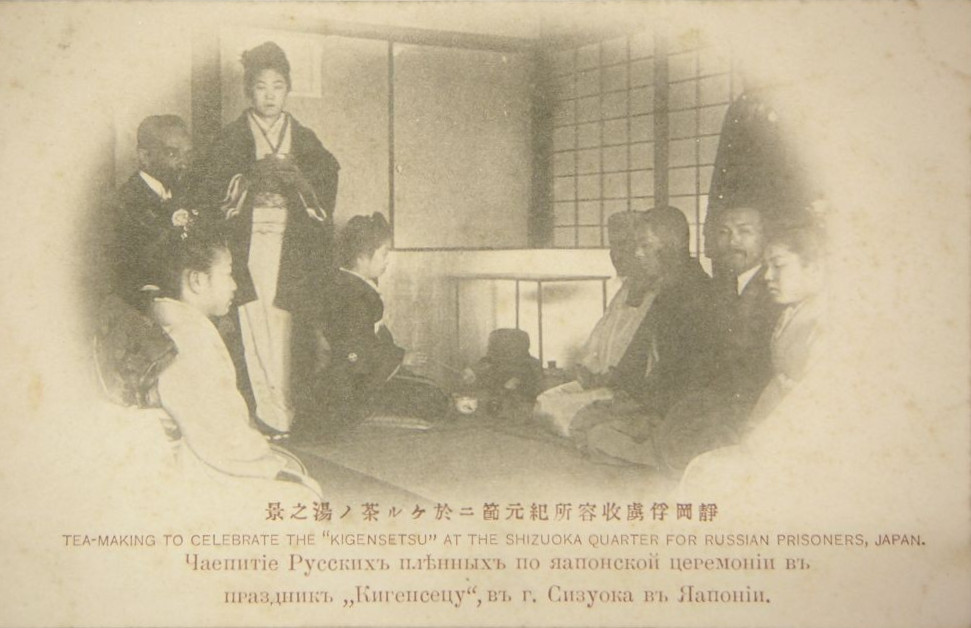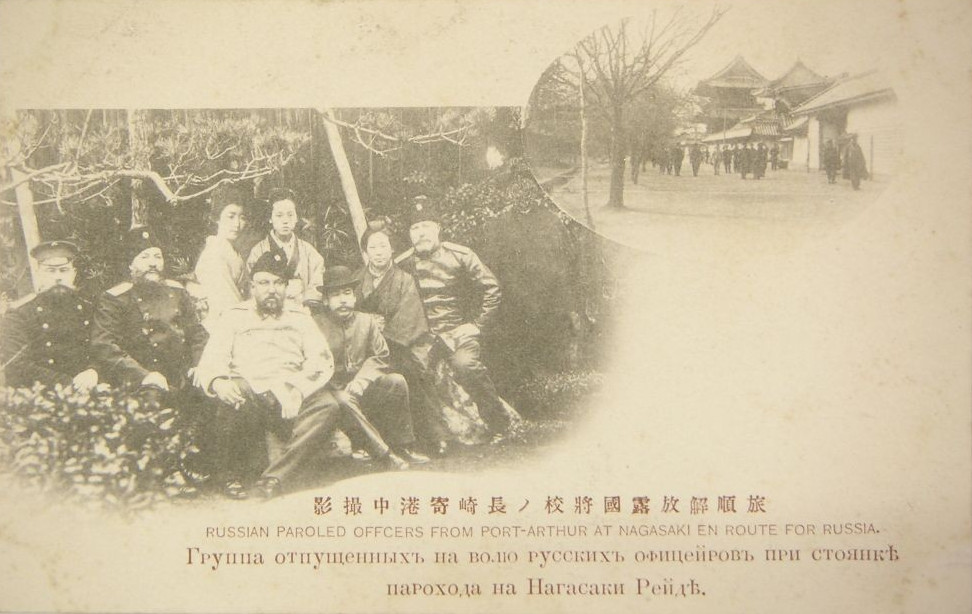The Russo-Japanese War and Steponas Kairys

The Russo-Japanese War (1904-05) had a significant impact on the early history of relations between Lithuanian and Japanese people. The fact that a small and at the first glance weak Asian country defeated the mighty Russian Empire caught the attention of the whole world, and this fact had a deep meaning for the Lithuanian people. First of all, Lithuanian soldiers participated directly in military actions. Secondly, this war showed occupied Lithuanian people that even a small country can defeat a large empire if it is well organized and united. This idea inspired one Lithuanian man named Steponas Kairys and immediately after the war, in 1906, he published books about Japan. These books were the first ones about Japan written in the Lithuanian language.
Lithuanians in the Russo-Japanese War
Lithuanian soldiers participated directly in the military actions of this war as the recruits who were forced to join the military service. In general, the Imperial Russian Army was multinational and consisted of Finnish, Polish, Latvian, Estonian and people of many other nationalities. The recruits followed different religions, had different identities, and spoke different languages. Japanese soldiers were surprised at these differences when they took the prisoners of war. Furthermore, soldiers of the suppressed nations were reluctant to go to the war, which was not theirs. Many cases of desertion occurred and the soldiers were full of joy after the lost battles to the Japanese, for instance, the Battle of Tsushima.

On the other hand, this war was a serious training ground to the majority of Lithuanians and they got new warfare skills, which could be used after 13 years, i.e., in 1918, for gaining independence from Russia. Many of these experienced soldiers formed the core of the army of the revived Lithuanian Republic.
Ir laisvė, ir civilizacija Japonijoj visgi aukščiau stovi negu Maskolijoj; [...] Šiuom kartu Europos tautoms didesnis pavojus gali grėsti nuo per daug susidrūtinusios Maskolijos negu nuo Japonijos. Todėl ir kare daugiau bus simpatizuojančių su Japonija negu su Maskolija.– „Lietuva“, 1904 m. sausio 15 d.
Both freedom and civilization stand higher in Japan than in Muscovy; [...] In this case, a greater threat to European countries would be too strong Muscovy than Japan. Thus, in war will be more people sympathizing with Japan than Muscovy.– “Lithuania”, 15 January 1904
Newspapers of the Lithuanian diaspora tended to represent Japan in a positive ad supportive way in the 20th century. Japan was described as an advanced country, which developed a counterbalance to Imperial Russia in the east.
(excerpts from newspapers "Lietuva" and "Vilniaus žinios", 1904-1905)
A significant part of Lithuanians together with Latvians, Estonians, and Finnish people was recruited as sailors in the Baltic Fleet, which determined the end of the Russo-Japanese War. This fleet left the port of Liepaja (Latvia), traveled a long way around Africa (a part of the journey went via the Suez Canal) to the Sea of Japan. On the 28th of May 1905, the Baltic Fleet lost the Battle of Tsushima. This was a decisive defeat. In this battle 21 ships of Russians were sunk, approximately 5000 sailors died and 6000 sailors, including many Lithuanians, were captured.
(Mary Evans Picture Library, Hulton Archive)
According to Ryo Kojima, the Japanese Secret Intelligence Services led by Baron Motojiro Akashi had a great impact on the dissemination of information and partiality during the Russo-Japanese War. There was an attempt to encourage the nations included in the Russian Empire and opposition movements to promote the idea of independence and cause instability in Russia. Little known and heard name of Lithuania more and more often appeared in the Japanese newspapers in this context.
(portrait of Motojiro Akashi)

Lithuanians as Prisoners of War in Japan

The number of captured prisoners was growing not only because the Japanese won battles one after another but also because a large number of the troops deserted. In total, there were about 80 thousand prisoners. The Japanese sent them to 29 camps for prisoners of war established around the country. The largest camp was Hamadera located in Osaka.
(Slavic Research Center Library, Hokkaido University)
Despite the fact that the prisoners were enemies, the Japanese dutifully followed the principles of the Hague Convention of 1899 and local people showed them warm hospitality. Japan earned the respect of the international community for this, and the prisoners of war had very good memories about the Japanese people.
Messages sent to the newspapers of Lithuanian diaspora by Lithuanian prisoners of war in Japan were very short – in most cases, words of gratitude for newspapers were presented and the joy that everyone was alive and healthy or got healed was expressed. It is possible, that detailed messages were forbidden due to censorship.
(Slavic Research Center Library, Hokkaido University)
Messages in the newspapers of diaspora suggest the fact that many Lithuanian people were in prisoner of war camp in Matsuyama (now – Ehime Prefecture). Around 6000 prisoners were calculated in that time when this camp expanded. The majority of prisoners had Polish and Lithuanian origins. It is assumed that this happened due to the leader of the Polish liberation movement Jozef Pilsudski. In 1904, he visited Japan and achieved an agreement with the Government of Japan regarding special conditions related to the Polish soldiers, who deserted the Russian army.
Matsuyama was considered to be the best prisoner of war camp of all 29 camps in Japan, where prisoners had convenient living conditions, medical healthcare, and even special food. Soldiers were free to walk around the city, go shopping, and go to the seaside. 98 prisoners died of war wounds and they were buried there. To the present day, well-maintained Russian soldiers' cemetery remains in Matsuyama, and Lithuanian surnames could be found on gravestones.
(Slavic Research Center Library, Hokkaido University)
Mums, kareiviams, jos (medicinos sesutės) yra tarsi angelai, tarsi atgaiva. Jų rūpestis pacientams - kaip tikrų motinų. Dieną ir naktį triūsdamos aplinkui, jos nevengia rūpintis žaizdotais kariais. Nesu matęs susiraukusio veido Jos tai daro ne tik iš pareigos, bet ir iš didžiulės atjautos karo aukoms.– iš F. Kupczinsky atsiminimų
They (nurses) are like angels to us soldiers, they are like refreshment. They look after patients like real mothers. Day and night they work hard and do not avoid to look after wounded soldiers. I have never seen a rumples face <...> They work not only out of a sense of duty, they are full of sympathy for war victims.– from memuars of F. Kupczinsky
Biography of Steponas Kairys

Steponas Kairys (1879-1964) is well known in Lithuania due to various reasons: he was one of the members of the Council of Lithuania (the Council signed the Act of 16th February in 1918 that announced establishment of the Republic of Lithuania), the gifted engineer, who developed water supply system in Kaunas, the rescuer of the Jews, one of the founders of Social Democratic Party and an active political figure. However, one of his life aspects often is forgotten – Steponas Kairys was the first Lithuanian, who wrote books about Japan in 1906.
He was inspired by the victory of Japan in the Russo-Japanese War. Despite the fact that he had never visited Japan, he collected and organized the material about this country at the age of 27 while studying and living in Saint Petersburg. Japan became an example of how a small state can overcome a much stronger nation if the state has faith, concentration and readiness to do it. Japan inspired S. Kairys to seek the independence of Lithuania.
Despite the fact that S. Kairys did not come back to the topic of Japan directly, all knowledge that he had put in books he used while establishing the Constitution of Lithuania and the independent Republic of Lithuania.
(click on dates to see more information)
-
 In 1879, born in the village of Užunvėžiai (Anykščiai District)
In 1879, born in the village of Užunvėžiai (Anykščiai District)S. Kairys was born in a big family of farmers. Actually, his real surname was Tumasonis, however, due to the mistake in christening documents, he became Kairys.
(memorial in the hometown)
-
In 1894, graduated from the Progymnasium of Palanga
After he graduated primary school in Kurkliai town, S. Kairys moved to Palanga.
-
 In 1898, graduated from the Gymnasium of Šiauliai
In 1898, graduated from the Gymnasium of ŠiauliaiHe was very active in the gymnasium and formed a group of people, who learned the Lithuanian language; also, he stood against forced attendance of the orthodox mass.
(left – at the time of Palanga progymnasium, right – after graduating from the gymnasium; S. Kairys Foundation archives)
-
1899-1908 studied in the Technological Institute of Saint Petersburg
In Saint Petersburg, Steponas Kairys lived and studied discontinuously. He graduated from the Institute with honor and became an engineer.
-
 In 1900, became an active member of the Lithuanian Social Democratic Party
In 1900, became an active member of the Lithuanian Social Democratic PartyHe had been one of the leaders of this party up to 1944. In 1904, a manifest of social democrats encouraging to seek the independence of Lithuania was established on his initiative.
(Socialdemocrats' faction at the Constituent Assembly of Lithuania, 1921, S. Kairys in the first row, third from the right)
-
 In 1906, published three books about Japan
In 1906, published three books about JapanHe admired Japan and the fact that this country defeated the Russian Empire; thus, he collected and systematized the material in the libraries of Saint Petersburg and Lithuania and put it in his books. He published them under the name Uncle (lit. Dėdė).
-
In 1912 returned to Vilnius, Lithuania
Since 1908 he had traveled around Russia and together with Petras Vileišis built bridges. Later he worked in Vilnius Municipality and was in charge of water supply and planning of the sewage system.
-
 In 1918, he became a signatory of the Act of Reinstating the Independence of Lithuania
In 1918, he became a signatory of the Act of Reinstating the Independence of LithuaniaOn the 16th of February, the independence of Lithuania was announced and Steponas Kairys was one of the most active founders of Lithuania. In the same year, he moved to Kaunas, which soon was announced as the capital of Lithuania.
-
 In 1919, he became a member of Seimas
In 1919, he became a member of SeimasS. Kairys had been elected to all Lithuanian Seimas up to 1926 and he actively participated in political activities as well as activities of the Social Democratic Party.
(memorial in Kaunas, Donelaičio str. 77)
-
 In 1923, he became the Head of the Department of Water Supply and Sewerage in Kaunas, started a family
In 1923, he became the Head of the Department of Water Supply and Sewerage in Kaunas, started a familyHe developed plans for water supply and sewage systems in Kaunas and other Lithuanian towns. He had led the Department until 1938 and gave lectures at Vytautas Magnus University.
In the same year of 1923, married Ona Leonaitė.
(S.Kairys Foundation archive)
-
 In 1942, during the time of the Nazi occupation, he had rescued the Jews
In 1942, during the time of the Nazi occupation, he had rescued the JewsTogether with his wife, S. Kairys saved the Jewish girl Anusė Keilsonaitė. In 2005, both were awarded as the Righteous Among the Nations after their deaths.
(S.Kairys Foundation archive)
-
In 1944, ran away to Germany
The Soviet occupation began and he ran away to Germany.
-
 In 1948, emigrated to the USA
In 1948, emigrated to the USAHe lived in the USA and continued to encourage people to not recognize the occupation of Lithuania.
-
 On the 16th December 1964, died in New York
On the 16th December 1964, died in New YorkHe was buried in a Lithuanian cemetery in Chicago. In 1996, after the restoration of the independence of Lithuania, his remains were reburied in Petrašiūnai cemetery, in Kaunas.
(gravestone in Chicago)
Japan in books of Steponas Kairys
S. Kairys wrote books about Japan under the name of Uncle (lit. Dėdė). They were published in 1906 and were quite popular. In his books, S. Kairys mainly discussed how this small state was able to defeat mighty Russia. He searched for an answer and analyzed the geography, society, and history of Japan.
“Past and Present of Japan“ (lit. “Japonija seniau ir dabar“)
This introductory book was aimed to discuss the nature, people, and history of Japan. S. Kairys presented the structure of society, compared it with Lithuanian examples, named the most important historical events, such as the emancipation from serfdom and the announcement of the Constitution.
Visa kalnuota, visa miškais apaugusi, žalia nuo pasėtų javų Japonija pavasarį ir rudens laiku esti panaši į gražų sodą.– 1 psl.
Japan is all covered by hills and forests, and when the land is green due to planted crops in the spring and autumn, Japan recalls a beautiful garden.– Page 1
“How the Japanese Live Now“ (lit. “Kaip japonai gyvena dabar“)
In this book, S. Kairys described different areas of life in Japan: roads, agriculture, trade and industry, education, and religion. As a social democrat, he paid attention to the issues of the working class. He admired the ability of the Japanese to understand innovations, adapt and use them.
Reikia apskritai pasakyti, kad reta pasaulio tauta temokėjo taip giliai atjausti mokslo naudingumą, ir jokia kita negalėjo taip greitai ir gerai perimti ir pritaikyti mokslo išradimų prie savo gyvenimo reikalų.– 33 psl.
Jeigu japonai per tris dešimtis metų suspėjo tiek daug naujų daiktų perimti iš Europos, galima spėti, kad ir toliau jie neapsileis. Ir gal už šimto ar kito metų Japonija virs Tolimųjų Rytų Anglija.– 9 psl.
It should be noted in general that there are not many nations in the world, which well understand the usefulness of science and only this nation is able to understand so quickly scientific inventions and adapt them to the way of living in the country.– Page 33
The Japanese were able to adapt to so many things from Europe during three decades and it can be presumed that they will not stop. And maybe after one or more hundred years, Japan will become England of the Far East.– Page 9
“The Constitution of the Japanese“ (lit. “Japonų konstitucija“)
This book was the most mature and critical book of all three. The character, customs, and laws of the Japanese were analyzed in this book. A lot of attention was paid to the process of the establishment of the Constitution in 1891 and how it changed the life of Japan. A significant part of the book was devoted to the Russo-Japanese War while searching for an answer to the question: why Japan overcome a much stronger enemy?
Užtat kuomet atėjo laikas kovon stoti, japonai buvo apsiginklavę nuo galvos iki kojų. Jie drąsiai užkabino priešą, visai nepasiruošusį, tamsų, vedamą drutų, bet nesumaningų perdėtinių. Jie parodė darbu ir mūsų kareiviams, ir caro vyriausybei, kad laisvi ir šviesūs žmonės gali paimti viršų ant tamsių vergų, nors jų būtų ir tris kartus daugiau.– 31 psl.
When the time came to join the fight, the Japanese were armed from their heads to their toes. They bravely challenged the enemy, which was unprepared, unlearned, led by strong, but ignorant authority. Their work proved to our soldiers and the Russian Empire that free and bright people can overcome ignorant slaves, although there would be three times as many.– Page 31
Bibliography
- Railienė, Birutė. 2012. Pirmosios žinios apie Japoniją lietuviškoje spaudoje. Stepono Kairio trilogija (1906 m.). Rytų Azijos studijos Lietuvoje (sud. Aurelijus Zykas). Kaunas: Vytauto Didžiojo Universiteto leidykla, p. 93-102.
- 渡辺克義編 『ポーランドを知るための60章』 明石書店、2001年、ISBN 4750314633
- 松本照男 日本に親近感を持つポーランド人 POLE 82 (2014.5)
- 高石市教育委員会/編集 2007 濱寺ロシア人俘虜収容所資料集
- 堀田昇吾編 ロシア兵捕虜、厚遇の跡 日露戦争時の大阪に収容所 日本経済新聞 2020年9月3日

























